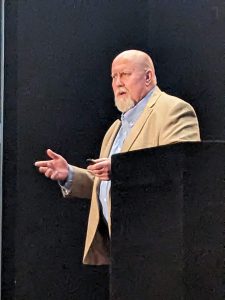
On March 7th, our very own, Dr. Ted Reynolds presented at the Learning Institute for Elders at the University of Central Florida event. His presentation, titled “When the Lights Go Out: The Evolving Threat to the U.S. Power Grid” served as a way to educate participants on the impact of a potential grid collapse, and the ways in which an attack on the grid could happen.
LIFE at UCF is an organization for people who are fifty years of age and older to gain learning experiences at UCF. The over eight hundred members of LIFE at UCF are given the opportunity to attend weekly presentations and lectures from a wide range of UCF faculty and professional members of the community. LIFE at UCF has generated a phenomenal partnership with the UCF community, where members of this program have access to UCF facilities including the John C. Hitt library, athletics events, and even serve as support and volunteer to be participants at some of the many different research projects throughout the University.
Dr. Reynold’s presentation took a deep dive into the ways in which potential grid collapse could happen, as well as the result of each and every one of these attacks. Three unique “primary threats” were used to explain the potential for an attack: physical attacks, cyber-attacks, and Electro-Magnetic Pulse. Each of these areas for an attack was filtered through the “Possibility-Probability” lens as proposed by Dr. Reynolds.
The Physical Attack Threat section served to open the presentation with a feasible and realistic but small-scale example of what an attack on the grid could possibly look like. Dr. Reynolds looked at recent events from hate groups, who used rifles to shoot out transmission transformers, which can shut out the grid for a specific area over time. The issue with attacks like these, while small scale, is the transmission transformers which, when in short supply, can take more than eighteen months to replace, and are manufactured mostly in China. The number of physical attacks to our grid has gone up about seventy-eight percent from 2021 to 2022, which is a number Dr. Reynolds only expects to increase.
The Cyber Attack Threat section explained how attacks like these can be one of the most devastating, and are growing increasingly more likely. There exists no major government regulation for cybersecurity, which leaves each entity and company on their own when it comes to securing their software. All of our systems, including water, nuclear weapons, and more are controlled by SCADA systems, which is a software that captures data in real-time and relays it to the different sensors and control-rooms that monitor the equipment that makes our country run. An attack on this would leave millions without food, water, and power and would be devastating to waste management and could block sewage systems. Another type of cyberattack is called Ransomware, which occurs when groups gain access to information from places like city governments, hospitals, and schools, and threaten to release said information unless a specific amount of money is paid to them. As was seen in Russia’s attack on Ukraine, cyberattacks will serve as the predecessor to kinetic action from military groups or terrorist organizations, which makes regulation and protection increasingly more important. But as mentioned above, there are few standardized cybersecurity protocols, other than the minimum standards set by insurance companies. These unfortunately, do not go far enough.
The third and final attack to the grid, which would be the most damaging but is the least likely is an Electro-Magnetic Pulse which could happen in one of two ways .The first way an Electro-Magnetic Pulse could occur is from a solar plasma ejection, or solar flare. The most recent event where this occurred on a large-scale was the 1859 Carrington Event, which melted telegraph lines across the country. A solar plasma ejection in 2023 would melt and kill any device with a chip in it – phones, computers, cars, planes, refrigerators, and more. The other way is via a Nuclear EMP Attack. Studies have shown that the detonation of a nuclear weapon, thirty miles above Earth would create devastating effects– and our adversaries know this. The Chinese balloon that flew across the United States was at about sixty thousand feet above the air, and has the potential to be one hundred twenty thousand feet high. The immediate effect of a Nuclear EMP Attack could kill roughly 200,000 people and prolonged impact could result in the death of eighty percent of the United States population (US Army report). It would turn off life support, planes would immediately fall to the ground, and refrigeration would not work.
There are lots of ways to mitigate these different threats against the grid, but resiliency is by far the most important. The biggest problem stems from a lack of debate about these possibilities from Washington D.C. because when they are brought up to Congress, they immediately get stricken down and tagged as “not probable”. Dr. Reynolds’ presentation for LIFE at UCF was a great way to inform members of the community about the possibility of an attack on the grid, the potential effects of an attack, and ways both we as citizens and the federal government should react to and be proactive about attacks on the grid.